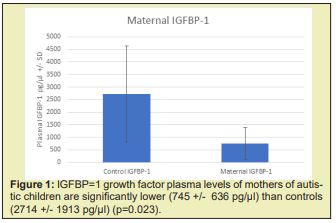IGF-I is an important growth factor and hormone which regulates protein turnover as well as having potent mitogenic and differentiating effects on most cell types.IGF binding proteins (IGFBP) act as carrier proteins and regulators by controlling bioavailability of IGF-I to tissues. We used immune-arrays to measure IGFBP-1in mothers of autistic children and found that the levels were significantly lower than levels in mothers of non-autistic children. IGF has been found to be decreased in autism. We suggest that these low levels are associated with low maternal IGFBP-1.
Keywords: Autism, Maternal, Growth hormones
IGFBP1: Insulin Like Growth Factor Binding Protein 1; IGF-1: Insulin Like Growth Factor 1; FGR: Fetal Growth Restriction
Fetal growth is controlled by genetic, environmental, and nutritional factors. The non-genetic elements become increasingly important in the second half of pregnancy and contribute to the natural phenomenon of maternal constraint on the size of the baby, so overriding paternal genetic influences. IGF-I is an important growth factor and hormone which regulates protein turnover as well as having potent mitogenic and differentiating effects on most cell types. In mothers whose pregnancies incur fetal growth restriction (FGR) IGF-I concentrations are greatly reduced.1 There are at least seven IGF binding proteins (IGFBP) that act not only as carrier proteins but also as regulators by controlling bioavailability of IGF-I to tissues. IGFBP-1 (synonymous with placental protein 12 and human pregnancy-associated endometrial α-1 globulin) has a molecular weight of 25 kilo Daltons and binds IGF-I to form a 34 kilo Dalton complex. This complex can cross intact endothelium and so may be involved in delivery of IGF-I to the tissues. Although in theory this could enhance IGF-I availability, IGFBP-1 inhibits IGF-I action in most in vitro systems and in blood. Several observations suggest that maternal IGFBP-1 is important in pregnancy. Concentrations usually rise rapidly in the first 12 weeks of pregnancy, and then remain high until delivery.2,3 Low IGFBP-1 has been associated with diabetes.4 IGFBP-1 is closely involved in carbohydrate metabolism,5 being regulated by insulin.6 In this study, we measured IGFBP-1 levels in mothers of individuals with autism and neurotypical, age and gender similar controls. We found that IGFBP-1 levels were significantly lower in the maternal autistic group.
Subjects
IGFBP-1 plasma levels were measured using immuno-arrays. Plasma from mothers of autistic individuals (n=17; mean age 32.3 years) and controls (n=15 females with no autistic children; mean age 28.2 years) were obtained from the Autism Genetic Resource Exchange (AGRE)**. This study was approved by the IRB of the Health Research Institute. Patient consent was obtained from all patients involved in this study and this study was approved by the IRB of the HRI. Cellular phosphorylated concentrations were measured using an Immuno-array assay described below.
Buffy coat white blood cells
All experimental and control cells were obtained from whole blood using centrifugation and were all treated identically then refrigerated (4C). Plasma and buffy coat samples were frozen at -70C and used for ELISAs and Immunoassay analysis.
Immuno-array assays
Immuno-arrays were performed by Ray Biotech, Inc, Peachtree Corners, GA. 30092 and described previously (19).
Statistics
Unpaired t-test and odds ratios with 95% confidence intervals were used for statistical analysis. Correlations were performed using Pearson Moment analysis also with 95% confidence intervals for determining statistical significance.
**We gratefully acknowledge that all autism family serums were provided by the Autism Genetic Resource Exchange (AGRE) Consortium and the participating AGRE families. The Autism Genetic Resource Exchange is a program of Cure Autism Now and is supported, in part, by grant MH64547 from the National Institute of Mental Health to Daniel H. Geschwind (PI)
In this study we found that IGFBP-1 plasma levels of mothers with autistic children are significantly low. Being regulated by insulin low IGFBP-1 has been associated with diabetes and carbohydrate metabolism. Insulin-like growth factor-1 (IGF-1) has become the center of concern in many laboratories. A deficiency in this growth factor, leading to insufficient neuron myelination and defective synapse function, appears to result in brain dysconnectivity during the first year of postpartum life, and cause social malfunction in childhood years and beyond.7-10 IGF has been found to be decreased in autism.11 We suggest that these low levels are associated with low maternal IGFBP-1. Our lab has also previously suggested that glucose metabolism may be associated with the etiology of autism.7-9 This data suggests maternal glucose metabolism may be related to etiology of autism.
None.
None.
The author declared no conflicts of interest.
- 1. Holmes R, Montemagno R, Jones J, et al. Fetal and maternal plasma levels of insulin-like growth factors and binding proteins in pregnancies with appropriately grown or growth retarded fetuses. Early Hum Dev. 1997;49(1):7–17.
- 2. Wang HS, Perry LA, Kanisius J, et al. Purification and assay of insulin-like growth factor-binding protein-1: measurement of circulating levels throughout pregnancy. J Endocrinol. 1991;128(1):161–168.
- 3. Hills FA, English J, Chard T. Circulating levels of IGF-1 and IGF-binding protein-1 throughout pregnancy: relation to birthweight and maternal weight. J Endocrinol. 1996;148:303–309.
- 4. Baldwin S, Chung T, Rogers M, et al. Insulin-like growth factor binding protein-1, glucose tolerance and fetal growth in human pregnancy. J Endocrinol. 1993;136(2):319–325.
- 5. Lewitt MS, Denyer GS, Cooney GJ, et al. Insulin-like growth factor-binding protein-1 modulates blood glucose levels. Endocrinology. 1991;129(4):2254–2256.
- 6. Holly JMP, Biddlecombe RA, Dunger DB, et al. Circadian variation of GH-independent IGF-binding protein in diabetes mellitus and its relationship to insulin. A new role for insulin?. Clin Endocrinol. 1988;29(6):667–675.
- 7. Russo A, Mensah A, Bowman J. Glucose Metabolism Dysfunction in Children with Autism?. EC Paediatrics SI. 2020;03:4–08.
- 8. Russo A, Mensah A, Bowman J. Increased Glycogen Synthase Kinase 3 Alpha (GSK3A) in Children with Autism. EC Paediatrics. 2020;9(20:01–05.
- 9. Russo A, Mensah A, Bowman J. Increased Receptor for Advanced Glycation End Products (RAGE) in Children with Autism. EC Paediatrics. 2020;99(5):31–34.
- 10. Steinman G. IGF - Autism prevention/amelioration. Med Hypotheses. 2019;122:45–47.
- 11. Riikonen R. Insulin-Like Growth Factors in the Pathogenesis of Neurological Diseases in Children. Int J Mol Sci. 2017;18(10):2056.


